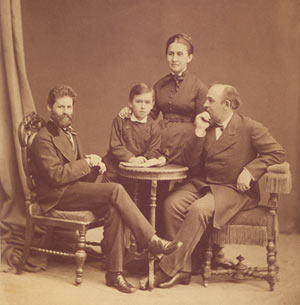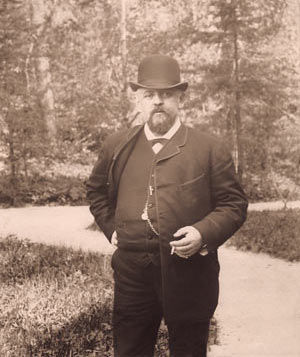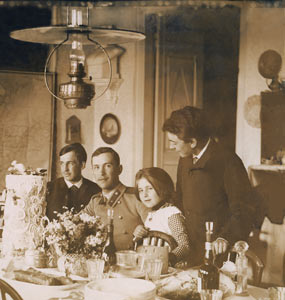THE MAMONTOVS' PERIOD Savva Mamontov (1841–1918) was born in an old merchant family in Yalutorovsk, the Tobolsk province (today the Tyumen region). His father Ivan Mamontov (1802–1869) founded a joint-stock company that built a railway connecting Moscow with Yaroslavl; he also financed the development of the first oil fields in Baku. Circa 1850 the Mamontovs settled in Moscow. Savva Mamontov studied first in one of the Moscow schools, then at the St. Petersburg State Mining Institute (1854–1855) and at Moscow State University (1860–1862) but he finished neither the first nor the second one. Ivan Mamontov looked forward to his son joining the family business and sent him to Baku for a trainee job (1862–1863), later he invited his son to work at the Moscow-Yaroslavl Railway Company's board of directors.
In 1865 Savva Mamontov got married to Yelizaveta Sapozhnikova (1847–1908) who was also a descendant from an old merchant family that owned the weaving factories. The young couple made their home on the Sadovaya-Spasskaya Street, in a house presented by Ivan Mamontov. The couple had five children – Sergey (1867–1915), Andrey (1869–1891), Vsevolod (1870–1951), Vera (1875–1907) and Alexandra (1878–1952). The first letters of their names made up the name of their father – Savva. After his father's death Savva Mamontov inherited a part of his fortune and became the director (1872) and then the president of the raised Moscow-Yaroslavl-Arkhangelsk Railway Joint-Stock Company (1894–1899). Abramtsevo was sold to Savva Mamontov in 1870 by the daughter of Sergey Aksakov. The first thing the new owners started was renovation. In the 1870–1880s the Manor House was repaired, the Kitchen and the servants' house were totally renewed. A wind water-pump station, a shed and a barn appeared in the northern part and a couple of greenhouses with strawberry and peach trees replaced the old fruit garden. To the south-west of the courtyard a stable and a coach-house came into sight. The yard with a "Dutch" dairy, a hayloft and a dacha called "Yashka's house" did not find enough space on the old estate territory and settled beyond its limits. Most of these buildings did not survive. Aiming to improve the local peasants' life Yelizaveta Mamontova organized the first hospital (1873) and a school (1874) in the district. This school gave basis for joinery (1876) where youth could get a profession. The joinery was thus preventing young people from leaving the village for town. These new buildings situated to the north-west from the estate got the name "The Cultural Settlement". They did not survive either. Being a businessman Savva Mamontov remained an artist in his soul: he was keen on fine arts, architecture and theatre. While studying in the University he participated in performances of the theatrical circle headed by the dramatist Alexander Ostrovsky, later he took lessons of singing in Milan, studied drawing in Rome. Since the end of the 1860s the house of the Mamontovs in Sadovaya-Spasskaya Street was opened for talented people – the artist Nikolay Nevrev, the architect Viktor Gartman and others. In 1872 the Mamontovs visited Italy where they became acquainted with the sculptor Mark Antokolsky, the painter Vasily Polenov and the art historian Adrian Prakhov. In the following years Ilya Repin, Viktor and Apollinary Vasnetsov, Valentin Serov, Ilya Ostroukhov, Yelena Polenova, Konstantin Korovin, Mikhail Nesterov, Mikhail Vrubel, Alexander Kiselev and others joined this circle. The informal community of these artists became well-known as the Abramtsevo Colony.
Since the end of the 1870s the participants of the Colony stayed and worked in Abramtsevo. The estate with its outskirts was the place where Ilya Repin painted "Easter Procession in the Kursk Province" (1880–1883) and "They did not Expect Him" (1884–1888), Viktor Vasnetsov – "Alyonushka" (1881) and "Bogatyrs" (1881–1898), Valentin Serov – "Girl with Peaches" (1887), Mikhail Nesterov – "Vision to Youth Bartholomew" (1889–1890). But the activities of the Colony were not limited to painting. Initiated by Yelizaveta Mamontova and supported by participants of the Abramtsevo Colony the collection of folk art was started in 1881 and continued to grow till the 1890s. This collection inspired the creating of wood-carved items in the joinery and Yelena Polenova, being the artistic director of the workshop from 1885 till 1892, made more than one hundred designs of furniture and other works. Later the joinery was headed by Maria Yakunchikova and Natalya Davydova. In 1890 Mikhail Vrubel became the artistic director of a new-built Abramtsevo pottery in the "Cultural settlement". The artist designed the tiled stoves for the Mamontovs` houses in Moscow and in Abramtsevo, he was also the author of numerous decorative sculptures and dishes. For more than 10 years the production in the pottery was headed by qualified technologist Pyotr Vaulin who made a valuable contribution to the work. Viktor Vasnetsov, Vasily Polenov, Valentin Serov, Konstantin Korovin, Alexander Kiselev, Andrey Mamontov and other artists also participated both in the work of the joinery and the pottery. Abramtsevo goods were in great demand in Moscow, St. Petersburg and other cities; they won prizes at prestigious exhibitions including the Paris Exposition Universelle (1900). In the 1890s similar artistic workshops appeared in the estates Solomenki and Talashkino owned by Maria Yakunchikova and princess Maria Tenisheva (correspondingly).
The owners of Abramtsevo supported the wide spread tradition of domestic performances. Savva Mamontov himself acted as a stage director and often as a dramatist. Everybody, who wished to play, chose the roles in the performances and Vasily Polenov, Viktor Vasnetsov, and other artists designed sceneries and costumes. These amateur performances contributed a lot to the creation of the Russian Private Opera in Moscow (1885–1891, 1896–1899) owned by Savva Mamontov. The architect Viktor Gartman designed the Pseudorussian Studio for sculpture lessons, built on the estate territory near the Manor House in 1873. This trend of eclecticism was supported by Ivan Ropet and in 1877–1878 the estate got a Bathhouse. Viktor Vasnetsov and Vasily Polenov worked on projects for the Church of the Savoir that was erected in the estate park in 1881–1882. And in 1883 near the church Viktor Vasnetsov set up a pavilion that for its fairy-tale view got the name "Hut on Chicken Legs". The church and the pavilion are the first buildings of the Art Nouveau style in Russia. In 1893 participants of the Abramtsevo Colony celebrated the 15th anniversary of their community. At the party Viktor Vasnetsov delivered the speech and the following year brought the anniversary edition titled "Chronicle of Our Artistic Circle", the cover designed by Vasily Polenov. Both the Vasnetsov's speech and the album described the amateur performances but the heritage of the Abramtsevo Colony was much more valuable and diverse. The Colony laid the foundation for the national Art Nouveau style, and to the great extent it formed the activity of the St. Petersburg "World of Art" association, the Moscow Art Theatre of Konstantin Stanislavsky and the European "Russian Seasons" by Sergey Dyagilev at the turn of the 20th century. The Abramtsevo workshops started the revival and development of traditional Russian crafts – wood-carving and majolica. Meanwhile the business of Savva Mamontov increased: he headed the construction of the Donetskaya Railway to coal beds, ruled the work of the Moscow Joint-Stock Company Rail Carriage Building Works, the partnership of the Nevsky Mechanical Plant, the Society of the East Siberian Iron-Smelting Plants. He became one of the founders of the Russian railway industry. But in 1899 Savva Mamontov was arrested for financial misuse and spent in prison several months. The following year Savva Mamontov was acquitted but his business came to ruin. The house in Moscow together with art collection was sold by auction to pay the debts. However, the estate Abramtsevo, that became the property of Yelizaveta Mamontova in 1880, was saved.
View the embedded image gallery online at:
http://www.abramtsevo.net/eng/history/the-mamontovs-period-.html#sigProGalleriacd23740c1a |




